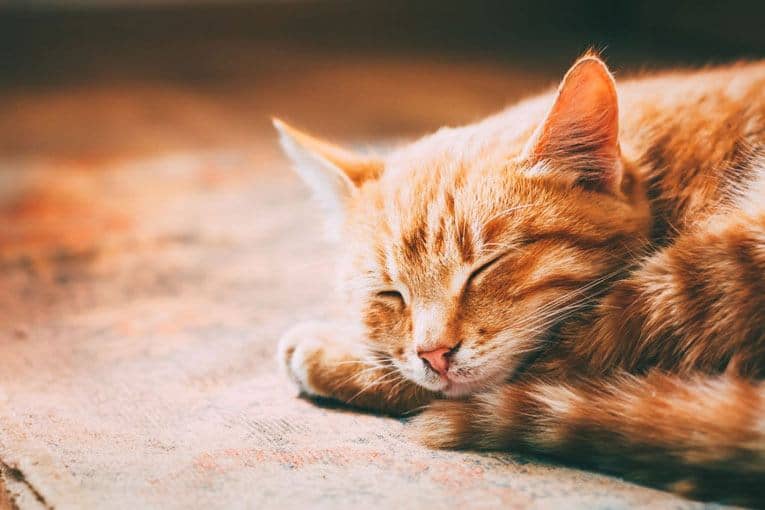Last Updated on 11/05/2020 by Veronica Jones
Cats are considered the connoisseurs of comfort. That’s why you’ll often seen them lazily sprawled out snoozing in a sunbeam or cozily curled up in a fur ball on the couch. It seems that cats can sleep nearly anywhere, anytime, and in any position. In fact, cats may sleep 16 or more hours a day, so it’s no wonder that their sleeping positions change. But is there more meaning behind the position that a cat is sleeping besides comfort? Maybe.
What Do a Cat’s Sleeping Positions Mean?
The position in which your cat is sleeping says a lot about how they are feeling and gives you a little insight into their psyche. Since our kitties can’t sit beside us and gush their feelings, understanding their different sleeping positions can help you know if they’re feeling insecure, cold, content, or playful. Let’s look into some common sleeping positions of cats and what each position tells us about what they are feeling.
The tight ball
A kitty sleeping curled in a tight ball with their head tucked under a paw or tail doesn’t mean they’re trying to block out a bad smell. Rather, cats in the wild use this position to protect their soft tummy and to conserve heat. It’s a real cat-eat-cat world outdoors, and kitties can never be too safe, especially when they’re at their most vulnerable time-sleeping. Even though your furry friend may not be in danger of low temperatures or predators, their instincts may tell them to sleep this way to protect themselves from prodding fingers.
A small space
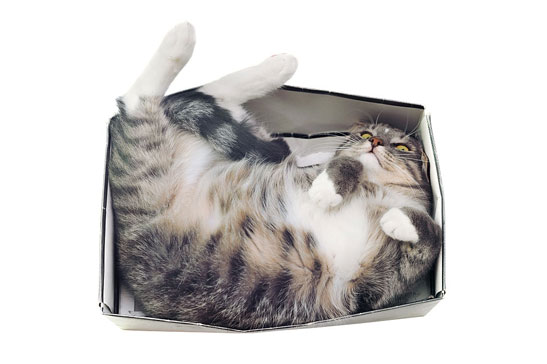
We’ve all seen our kitties stalk an empty box or paper bag like it’s the biggest, tastiest-looking mouse they’ve never seen, and then watched them play in that box for hours on end, batting and chasing imaginary beings. But what does it mean when they fall asleep in that box? When cat’s squeeze in to tiny spaces for a quick snooze, it most likely means they’re looking for a little security. Maybe you have some noisy houseguests or are in the middle of rearranging the furniture. A box or small space with four walls that they can hide behind provides them with that sense of security in which to sleep that they may be missing out in the rest of your house.
Belly up
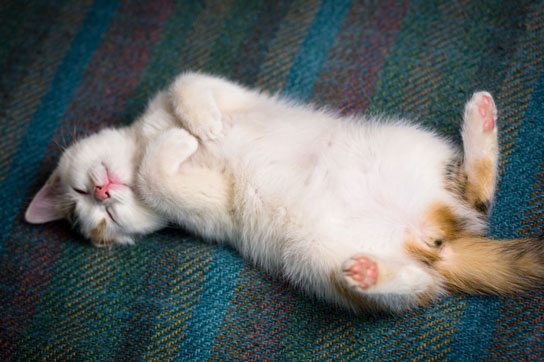
Unlike a belly up fish in your aquarium, a belly up sleeping cat is actually a good thing. Kitties may be fierce fighters, equipped with sharp teeth and claws, but the belly is a weak and vulnerable area which they normally try to protect. When a cat sleeps belly up it means they have full trust in their situation and the people around them. They don’t have any fear of an attack and are willing to let it all hang out there.
The cat pile
In the wild, many cats live in colonies, prides, streaks, whatever you choose to call it-groups. These groups allow them to hunt together and take care of each other. They also tend to sleep in piles to conserve heat and for protection. If you have multiple feline friends that are chummy, you’ll more than likely catch them curled up together or at least in the same vicinity and position. If your cats would rather not have a furry roommate, this probably won’t be the case and they’ll choose to sleep solo instead.
A quick doze
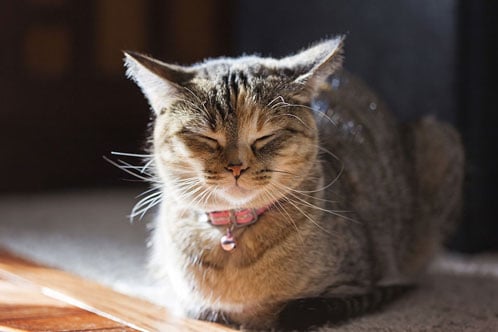
When a kitty doesn’t want to fully commit to a nap, they may choose to get a little shuteye in an upright position. They will tuck their feet under their body, but their head will remain up and eyes closed. It’s a way of grabbing a little sleep, yet still allowing them to be alert should they need to spring into action. I often see my barn kitties partaking in this sleeping position when they’re just trying to soak up a little sun while still remaining semi alert in case the dog happens to come by looking for trouble.
Side sleeping
Fully stretched on their side can be the ultimate position of contentment and relaxation. You may find your kitty sleeping on their side after a long play or grooming session, particularly if there’s a sunbeam to be found.
Sleeping on you
Congratulations, you’ve officially been inducted as a member of your cat’s clan! Sleeping on you shows the upmost trust. Similar to how multiple cats that get along sleep in snuggly piles, your cat sleeping on you is their way of incorporating you into their trust circle. But why on your face? Some cats just want to be near you and get your attention. What better way to do that than plopping down right in the middle of your face?
Eyes open
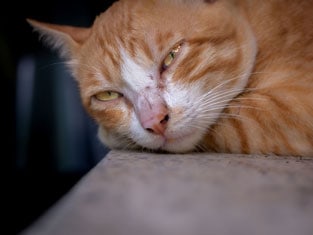 So, this isn’t technically a sleeping position, but it’s one that some cats spend quite a bit of time in. When a cat lays down, whether that be upright with feet tucked under, on their side, back, or stomach, and lazily keep their eyes partially open, they’re just trying to keep tabs on their surroundings while getting a little rest. Cats are curious and love to know what’s going on around them. Their eyes may seemingly stare unfocused or they may be locked in on you, the dog, or the mesmerizing snowflakes falling outside. Either way, they’re giving themselves a little downtime without fully shutting down.
So, this isn’t technically a sleeping position, but it’s one that some cats spend quite a bit of time in. When a cat lays down, whether that be upright with feet tucked under, on their side, back, or stomach, and lazily keep their eyes partially open, they’re just trying to keep tabs on their surroundings while getting a little rest. Cats are curious and love to know what’s going on around them. Their eyes may seemingly stare unfocused or they may be locked in on you, the dog, or the mesmerizing snowflakes falling outside. Either way, they’re giving themselves a little downtime without fully shutting down.
Cat Sleeping Positions That Could Indicate Something is Wrong
While most of the time your cat’s sleeping positions are picture worthy, sometimes they can indicate that something is wrong. If your cat is sick or in pain, they may assume some of these sleeping positions. The key is to know what is normal for your cat and to look out for other symptoms.
Cats that are trying to conserve heat may sleep in a tight ball. We know that already. But sometimes a cat may be running cold due to an illness or injury. If they seem to be sleeping in a ball more than usual or are seeking out other heat sources when they don’t usually, something may be wrong. Look for other signs of illness, such as decreased appetite, vomiting, diarrhea, or discomfort as well.
Side sleeping can also be an indicator of illness or discomfort. Kitties that are experiencing arthritis or other joint pain may choose this position because it doesn’t cause wear and tear. Cats that are having respiratory issues may also lay on their side to relieve pressure on their chest, making it easier for them to breathe. Both of these issues will show up with other problems as well, such as reluctance to jump or play, panting, or labored breathing.

